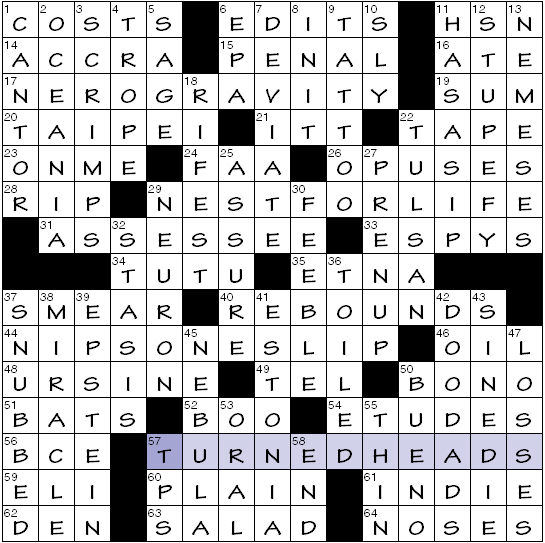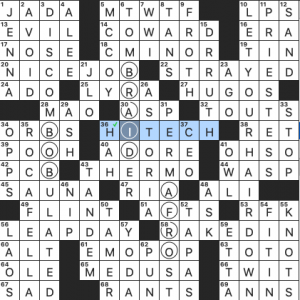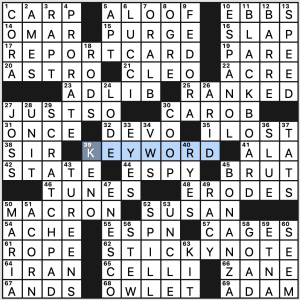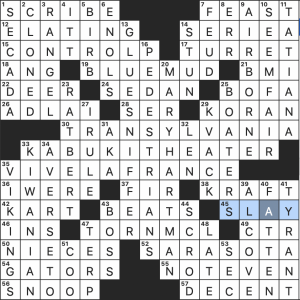Portia Lundie’s New York Times crossword—Jenni’s review
This smooth Monday is Portia Lundie’s debut in the NYT daily puzzles. They have constructed Midi (9×9) puzzles for the NYT Crosswords App. I hope to see more from Ms. Lundie. Constructing good Mondays is not easy, and they have a knack for it.
I figured out the theme pretty early on and was delighted by the unexpected revealer. All the theme entries go in the same direction and each has circles.
- 3d [Completely confused] is DISCOMBOBULATED.
- 6d [Lara Croft, in film] is the TOMB RAIDER.
- 31d [Layer of soil that never thaws] is PERMAFROST.
And the revealer: 10d [“Loosen up!”…or a hint to this puzzle’s circled letters: LET YOUR HAIR DOWN. BOB, BRAID, and AFRO are all hairstyles going down. Nice!
A few other things:
- I enjoyed seeing JADA at 1a and JENNA at 1d. I know it’s sometimes troubling to have two names crossing. I can’t think of another proper name in the format _ENNA so I think it’s a fair intersection.
- I met DR RUTH once when I was in college. She was delightful – smart, empathetic, and funny as hell.
- Conversational clues that I enjoy: 20a [“You did it!”] for NICE JOB and [“That’ll be the day!”] for HAH.
- The long downs are fun: PRIESTESS and ROCAFELLA.
- Could have done without OPPS.
What I didn’t know before I did this puzzle: that Billie Eilish’s genre is EMO POP.
Jared Goudsmit’s Los Angeles Times crossword — Stella’s write-up

Los Angeles Times 2/8/21 by Jared Goudsmit
Y’all, I haven’t enjoyed a Monday this much in a long time. This appears to be a constructing debut, and a very fine one it is!
There’s nothing complicated to this theme at all; the central entry at 38A, B AND B [Inn offering a morning meal, briefly … or a hint to six puzzle answers] is more of an extra touch of elegance than a revealer. I don’t think you need it to know that the theme entries are all two-word phrases in which both words start with B:
- 17A [Foamy tubful for unwinding] is a BUBBLE BATH, which sounds lovely as I shiver and look at the giant piles of snow on the sidewalk out my Brooklyn window.
- 27A [Lumber on a diamond] is a BASEBALL BAT. This is the only theme entry with a slightly tricky clue, although you don’t need to solve puzzles for very long before the word “diamond” makes you think of baseball before you think of elemental carbon.
- 47A [Bryan Cranston crime drama] is BREAKING BAD, a show everyone in America seems to have seen except me.
- 62A [Fish-and-chips coating] is BEER BATTER. Yum yum YUM.
- 3D [Infant’s source of nourishment] is a BABY BOTTLE, a phrase that immediately evokes Maggie Simpson for me.
- 30D [Icon with a left-facing arrow] is BACK BUTTON, which I hope you won’t hit on your browser before you finish reading today’s reviews.
Sure, themes of alliterative phrases are as old as the hills. But this is such a nice example of how it doesn’t matter that a constructor is using a trope if it’s as well executed as this is. There are 62 thematic squares, not counting the central revealer, and every theme entry crosses at least one other theme entry. So, holy wow, that’s an achievement!
But more important to the solving experience than how impressive the theme construction is, I think, is how evocative the theme entries are. Fill in 17A and you think of taking a nice relaxing soak; fill in 27A, you hear the crack of a ball on a bat; I can picture Walter White in my head even though I’ve never actually seen 47A. And, sigh, 62A makes me think of how nice it’d be to have some well-made deep-fried food, which is something that I haven’t really done since Before Times. Someday I’ll eat at a fish shack again…but see what I mean about being evocative?
The fill is not only fine, it’s got the gem of astronaut Mae JEMISON in the upper right; I’ve only ever seen her first name as an entry before, I think.
Bottom line: This is a beautiful Monday puzzle. I hope to see more from Jared Goudsmit!
Stephanie Lesser’s Wall Street Journal crossword, “Open-Ended”—Jim P’s review
It’s another debut! Congratulations, Stephanie!
The revealer is KEYWORD at 39a [Database search option, and a hint to the ends of the starred answers]. Each entry ends in a word that can follow “KEY.”
- 17a. [*Performance evaluation] REPORT CARD. Key card. (Though “card key” is also a valid phrase.)
- 62a. [*Highlighter alternative] STICKY NOTE. Keynote.
- 11d. [*It may be at the head of the class] BLACKBOARD. Keyboard.
- 29d. [*Spot to jot] SCRATCH PAD. Keypad.
Solid entries, accessible theme. Just right for a Monday. There’s also sort of a loose school theme pervading the entries, which I kinda like. Well done.
Top bit of fill has to be BONANZA which is always a fun word. Soup TUREENS and ESPAÑOL are nice as well, and I’m partial to “JUST SO” which sounds quaintly refined to my ear.
ENESCO is tough for a Monday as is odd plural CELLI. And square one turned out to be harder than expected since 1a [Complain] could be HARP as well as CARP, and 1d is [Red Sox manager Alex] whom I don’t know. Luckily I guessed CORA correctly.
Clues of note:
- 33d. [Peer group?]. EYES. Whoa. That’s tricky for a Monday (but good). Didn’t get it until just now. “Peer” as in “to look.”
- 50d. [Bartiromo of Fox Business]. MARIA. I wish we wouldn’t give our precious crossword time to those who propagate Trump’s lies.
- 59d-63d. Every once in a while, the WSJ puzzle is missing the final few Down clues. Such is the case here.
Nice puzzle. 3.6 stars.
Patrick Berry’s New Yorker crossword – Rachel’s writeup
First of all: The New Yorker announced today that the crossword will be appearing in the print edition of the magazine going forward (full announcement here). This is huge news and a well-deserved show of confidence in the talent and artistry of their constructors, who make some of the best themeless crossword puzzles you can find in a mainstream publication. This will have a huge impact on the size of the their solvership, and I’m just so thrilled for this talented team to reach a wider audience. Congratulations, New Yorker constructors!!!
And to celebrate this excellent news, let’s look at Patrick Berry’s challenging Monday puzzle. I didn’t think this was particularly hard, but I [Very much indeed] enjoyed the solve. The long entries were all pretty fun (ORRIN HATCH notwithstanding), the wordplay was clever, and the trivia was great.
Highlights from the long stuff: CALCULATORS / PENNY ARCADE / ABANDON SHIP! / PRIME MOVER / PARADE REST / DIANA ROSS / LOST WAGES. To illustrate Jenni’s point in the comment about “boomer-centric” easy entries, I’ve never heard of or seen MARATHON MAN. And to the larger point, that’s ok! I still found so much in this puzzle to relate to. In fact, despite the near certainty that Patrick Berry and I went to high school in different eras, this puzzle reminded me of high school in many ways—CALCULATORS! Reading the webcomic PENNY ARCADE (admittedly not what this entry was clued with)! Seeing high school productions of the Wiz (admittedly not starring DIANA ROSS)! Just a fun set of long entries.
A few more things:
- The thought of the droplets that would be produced by 5000 KAZOOS being played at once made me *shudder* [Instruments played by over five thousand audience members in a record-shattering (and ear-shattering) 2011 Royal Albert Hall performance]
- Favorite clues:
- Favorite wordplay clue: [Many go overboard upon hearing it] for ABANDON SHIP
- Favorite trivia clue: [Country name that replaced (and was later replaced by) Democratic Republic of the Congo] for ZAIRE
- I’m at the wordplay clue, I’m at the trivia clue, I’m at the combination wordplay clue and trivia clue: [Punny nickname for Sin City] for LOST WAGES
- For anyone who may be wondering, [Brick in a brickfilm] is LEGO because the main character in “The LEGO Movie” was a LEGO man named Brick
Overall, tons of stars from me. See you Wednesday!
Paul Coulter’s Universal crossword, “Knocked Sideways” — pannonica’s write-up

Universal • 2/8/21 • Mon • “Knocked Sideways” • Coulter • solution • 20210208
- 57aR [Attracted attention … or what 17-, 29- and 44-Across have, based on their first letters?] TURNED HEADS. The three phrases all begin with a Z which, when rotated, becomes an N.
- 17a. [What kept an infamous emperor grounded?] NERO GRAVITY (zero …).
- 29a. [Pair up permanently, as pigeons?] NEST FOR LIFE (zest …). Wikipedia sez: “Current evidence suggests that wild, domestic and feral pigeons mate for life, although their long-term bonds are not unbreakable. They are socially monogamous, but extra-pair matings do occur, often initiated by males.”
- 44a. [Has a mishap similar to biting the tongue?] NIPS ONE’S LIP (zips …).
There are no Zs in the grid, though there are additional Ns that are not-formerly Zs. To have arranged that would have been a much greater constructing feat, and certainly would have made this crossword much knottier.
Even so, there is some iffy-for-an-easy-puzzle fill, such as ASSESSEE, SINE DIE, and RIFEST.
-

This view looks the most like bamboo to me. It seems that the design elements are ‘inspired by’ the shape of bamboo shoots, but not necessarily the shape of the overall structure.
Today’s geography lesson is world capitals. 14a [Capital of Ghana] ACCRA, 20a [Asian capital with a bamboo-shaped skyscraper] TAIPEI, 41d [Tallinn’s land] ESTONIA.
- 9d [Picture that can’t be Photoshopped] TATTOO. Though a picture of a tattoo can be photoshopped. And then there are the likes of this and this.
- Favorite clue: 27d [Union contract] PRENUP.
That’s all I’ve got today.
Brendan Emmett Quigley crossword (No. 1338), “Themeless Monday #607” — Jenni’s review
This one was harder than Brendan’s most recent Themlesses, and I enjoyed every minute of it.
Highlights:
- BIRB, which makes me laugh. See below for the meme that taught me about birbs
- The center across stack of TRANSYLVANIA, KABUKI THEATER, and VIVE LA FRANCE. There’s an absurdist play in there somewhere.
- The center down stack (is it a stack if it’s vertical?) GLUE SNIFFER, PEDESTRIANS, and MARY HARTMAN. Very 1980s.
- [Job discussion?: Abbr] for SERMON. Job as in the book of the Bible.
- Disambiguation: ANG is Angola, which borders the Democratic Republic of the Congo, or DRC.
What I didn’t know before I did this puzzle: never heard of BLUE MUD. The resident geologist is not a sedimentologist. Did not know the TERPs were part of the Big Ten. Had never heard of a SLAY queen, which seems to have shifted from a term of admiration in the drag community to one of opprobrium in the straight world, because of course women who care about their appearance are shallow/nasty/obnoxious/stuck-up. And women who don’t care about their appearance are slobs/slackers/undateable/unfuckable. Verse #1,204,505 of the old standard, “Women Can’t Win.”





NYT: I think this puzzle is misplaced and should have appeared on a Tuesday. The theme is clever and the revealer fun. But I think there are too many names/pop culture of a particular ilk for a Monday. It’s not necessarily the constructor’s fault but it winds up hurting the ratings…
Or maybe for a newbie who knew those names and that pop culture, it might feel more accessible. Rachel’s New Yorker reviews have opened my eyes to how Boomer-centric my idea of “appropriate easy entry” is. And then there was Erin’s review a few years ago when she mentioned she’d never heard “The Times They Are a Changin’.” Made me feel old and reduced my internal criticism of more recent pop music references in puzzles.
I don’t look at puzzles with the same analytical eye as some of the Fiend reviewers, so I don’t remember offhand if there was another name/name crossing aside from the one I mention. I can see how a number of those would be problematic and I might well have solved without noticing them. I suspect yours will be the majority opinion in this group and I’m glad you mentioned it. This is part of the inclusion discussion we’ve been having.
I agree with Jenni! As someone under 35, this puzzle was right in my wheelhouse and much easier for me than your average Monday. JADA Pinkett-Smith and JENNA Maroney crossing at 1-Across were both dead gimmes that made me smile.
First – the WSJ was toothy for a Monday today but pretty darned good, I thought.
to the NYT point – For some people long down answers are sticking points as seemingly a majority or plurality of Mondays use downs primarily for connecting the dots, ceremonious filler if you will. These to novices I imagine can be real sticking points, I thought Tu or even W for this puzzle but I’m a dreaded old white-ish male including a personal raise of the eyebrow to non-horizontal 15’s not in a Sa or Su.
There is a tendency to include more and more pop culture and (lamentably) proper names in puzzles the past few years which I see as a result of the internet and multiple sources exploding the number and access to puzzle for better or worse.
We’re all going to get categories we blank on – just watch few Jeopardy! shows …
Finally (!!!) some puzzles such as New Yorker just make me reset my brain to what I will expect an answer to be, there is indeed a lot of just plain old rote to CWP.
Cheers,
After watching the Super Bowl half-time show, I am unsure as to whether there is such a thing as “pop culture.”
POP(ular) Culture is of course oxymoronic. Popular reflects that elusive mean/average/mode/normal continuum.
I would never tell the sommelier “Kindly give me a bottle of what is most popular”.
;–)
WSJ: Open Ended? How about UN-ended. Leaving out clues is not a theme. And it make the puzzle unusable with Across Lite. Could have been a good themeless.
I can’t open the WSJ Across Lite file. Anyone else having trouble? Is it reachable only on the PDF?
The corrupted WSJ app file made a corrupted AL file. I’ve replaced it with a good one now.
Success with the good file; thanks, Martin. The corrupted one shows as a blank in my AL library, and the app crashes when I try to delete it. Any suggestions?
What is the AL library? How do you display that?
It’s a display of all the puzzles I’ve opened. As the new ones come in, I trash the previous day’s.
It shows automatically on my AL screen. I don’t recall selecting it and don’t see any setting that allows me to remove it. So now I have four versions of today’s puzzle. Three of them crash the app and I can’t delete them in the usual way.
I don’t see that same list so I’m not sure where it is. Are you on Windows or Mac? Those files are somewhere in the file system. The operating system delete command would work, but you have to find the folder they’re in.
I’m on an iPad.
Funny, whether or not I’ve had a current dead tree sub to WSJ or not, there is always access to the puzzle on WSJ . com. I have never had a problem with the WSJ site on a PC, yet I hear of so many problems with fill disappearing and corrupted files.
I solve about 50/50 on paper solving while having breakfast
Do you solve with the WSJ app? That’s where the corrupted version first appears when this happens. The final clues are missing. The pdf is not affected, so if you solve on paper you wouldn’t see the problem.
No, I was just offering that the applet(?) on the WSJ webpage has never been corrupted that I have encountered and A) one need not subscribe to use it, B) I use it ~50% of the time.
Across Lite still not working for me for WSJ, as of 8:19 a.m. pacific. Brings up a webpage saying that Across Lite has stopped working, and windows will close the program. This is in Chrome, I haven’t tried another browser. I did clear my cache.
AL is working fine for other puzzles.
Maybe you browser has cached the bad version. Does this link work for you?
http://herbach.dnsalias.com/wsj/wsj210208.puz
YES!! I thought clearing my cache earlier might work, but it didn’t. Your link worked fine (using the right-click, open link in new tab which I’ve had to do in chrome for a while.
Thanks for your help!
NYT: Have I lost all my musical knowledge? Does C MINOR really have 3 flats?? I thought it was just 1 — E FLAT.
Anyone???
C minor is the relative minor of E flat major and thus shares E flat major’s key signature which has 3 flats (B flat, E flat, and A flat).
The New Yorker online actually seems to say that one puzzle will appear in print each week, varying in difficulty, while three will continue to appear online (Monday, Wednesday, and Friday). I’m guessing that means that they’ll vary in print as to which day’s puzzle they run.
And can I offer, hesitantly, another take on the question of pop culture and obscurity that’s been in discussion here and comes up again today in earlier comments? I appreciate the thoughtfulness that others have shown.
That said, my take is different. For me, the discussion seems to imply that everything is about pop culture after all and that everything is about personal experience. It’s just that our experiences vary. But it’s not simply that some like me are nostalgic for our youth and closed-minded about the present. I don’t want more clues about hit tunes from fifty years ago. Good grief!
Rather, first, I’d hate to be closed minded about the past any more than about the present. Don’t know “The Times They Are a-Changing”? I know plenty of classics from before I was born (and that one is arguably a landmark, but never mind). I pored over my father’s sheet music and anyway know a lot of it as the basis of jazz improvisations that continue to this day. I taught myself jazz history, excitedly, and went each week in my 20s to revival houses to learn more about old movies. It’s worth it. Shouldn’t you know who Alfred Hitchcock is and have enjoyed Citizen Kane?
Second, there can be value above and beyond that in going beyond pop culture. What about art and literature? When Shortz tells his setters he aims at a literate audience, shouldn’t we mean that, too? For my money, jazz, classical music, the movies, and even pop music can be part of that highbrow heritage, too, and I’m grateful for it. I reread Gatsby just two weeks ago and am reading a French author that a bookstore recommended.
Third, is it really in accord with what NY Times readers read to go by Shortz’s puzzles? I don’t have the expertise, and I’m grateful to others who have taken the trouble to pore over NY Times articles for support. Still, I can’t help thinking that the Sunday Book Review does NOT devote 90 percent of its articles to Harry Potter and Eloi. The Times arts page online right now features three gallery shows worth seeing, but it leads with Florine Stettheimer (a neglected woman artist we men should learn to know), Frank Stella, and Cubism. A series of articles spurred by a new movie revisits the old argument over who should take credit for Citizen Kane, Orson Welles or the screenwriter, and, yes, revisits a film critic on that question, Pauline Kael, from maybe before you were born. It has an article about a Peter Serkin, with clips of his performance of Bach, and one in a series of articles getting you into classical music, this time string quartets. So I have at least anecdotal evidence, too.
Hi John, I appreciate reading this comment since it shows me where people are coming from on this and other recent puzzles. I think it does come down to this idea of “highbrow heritage” – what does that actually mean, specifically? I’ve had to learn all sorts of golf terms, sailing terms, film actors from before my parents were born, etc, to be able to solve the daily puzzles. So why shouldn’t older solvers be expected to learn a thing or two about videogames, modern classics like 30 Rock, and (let’s just say it) Black American culture? Why aren’t these things “highbrow”? Are we not in Shortz’s “literate audience”? I went to Harvard, grew up on Beatles and Bob Dylan, have seen and studied Citizen Kane (I prefer Wall-E, personally) and I am very happy to see Lara Croft and Red Table Talk in the puzzle.
I’m not saying we have to toss Bach – just, why can’t we have Erykah Badu too? History is important, of course! And have we ever seen Fred Hampton in the puzzle, or COINTELPRO, for that matter? Are those not significant parts of American history? Jazz is highbrow enough, but not hip hop? Some of the greatest poetry of the last century has been delivered over beats – just because Will Shortz doesn’t listen to Kendrick Lamar doesn’t mean you can’t or shouldn’t.
I think everyone recognizes that we (as a society) are going through a moment of questioning and broadening what we consider a part of “our” heritage, and I very much welcome the change. So many of my friends have no interest in crossword puzzles because they find the content stale and irrelevant. Today’s puzzle is one I can happily recommend them.
Will (and the Times in general) have defined “literate” in a Eurocentric, White, Harold Bloom way for years. I think that’s changing and I think it’s well past time it should change.
There are loads of smart, word-loving people who have never read Gatsby or anything originally written in French. They might enjoy crossword puzzles. Will’s attitude has told them that the NYT crossword isn’t for them, and since the NYT has defined the genre, that’s a very bad thing.
“Highbrow” is a gatekeeping word usually wielded by people who are attempting to keep the gate closed and prevent the unwashed masses from getting inside. They often insist that it’s just pure coincidence that the people inside are mostly white and that the people in power inside the gate are mostly male. Pay no attention to the privilege behind the curtain. A year ago, before the world turned upside down, I spent two days on a train with some folk musicians and a bunch of fans, and had a very interesting conversation with Livingston Taylor about gatekeeping. He was lamenting the changes in the music industry not just because it makes it harder for artists to get paid but because “anyone” can put up music on the internet and that debases the field. He would like to return to the days when A&R reps were gatekeepers (his word) and maintained quality. As an example, he told us that the same A&R rep signed Dylan and Springsteen. I pointed out that both Dylan and Springsteen are white guys, and perhaps the gate needs to be swung open just a tetch wider. He was unconvinced.
“Casablanca” was a B-movie that nobody considered “highbrow” when it was made. Hitchcock was not called an auteur until the French New Wave anointed him. It doesn’t matter what yardstick you use – the measurement depends on who is holding it.
Rachel, you can take all MY stars, sneaking in a Das Racist reference amid all the deep philosophizing about generational touchstones.
THANK YOU!
This puzzle was great! I am often off put by obscure pop culture reference in NYT puzzles, but all of the clues and entrees were very accessible and common knowledge. I find it very hypocritical people are complaining about a main character in a popular tv show as a entree, when only a week or so ago “the godfather of modern electric guitar” was a clue that got no backlash… great puzzle. It is not a lot to ask older puzzlers to learn about modern tv shows if we are expected to learn winning horses from the 90s and obscure boat terminology.
Agreed, this puzzle is great and more puzzles should be like this one in terms of replacing outdated pop culture knowledge with newer more accessible content.